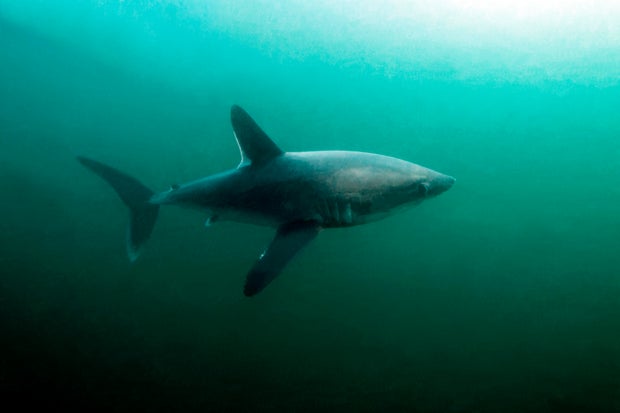In the ocean food chain, large sharks generally only have to worry about maintaining orcas at a distance — but new research suggests the top predators may need to be on their own guard.
Researchers have found evidence suggesting the first known case of a porbeagle shark — which can grow up to 12 feet long and weigh 500 pounds — being killed by a large shark predator. The findings were published Tuesday in the biological journal Frontiers in Marine Science.
This isn’t the first case of “shark cannibalism.” Jon Dodd, director of the Atlantic Shark Institute, which helped lead the study, said larger sharks eating smaller sharks is a common occurrence. “In the open ocean, size matters, but there’s always something bigger,” he said.
In some cases – bull sharks, mako sharks and baby sand tiger sharksfor example — sharks even eat their own kind.
But instances of large sharks eating other large sharks, the subject of this study, are rare, said lead researcher Dr. Brooke Anderson, a marine biologist for the North Carolina Department of Environmental Quality.
The death of the female porbeagle raises questions about whether this incident represents a broader trend among large predators, Anderson said. “With advances in technology, it’s possible that this is happening more often than we’ve been able to detect,” Anderson said.
The number of sharks being eaten by other sharks is impossible to say, Dodd said. “But if our experience at the Atlantic Shark Institute is any indication, it could be more than we think.”
A group of US scientists discovered the porbeagle’s death during a satellite-tracking project in the northwest Atlantic Ocean to better understand the shark’s whereabouts, behavior, and environmental preferences. They were particularly curious about female porbeagle sharks, which are known to travel long stretches of ocean to give birth to their young.
“We mainly wanted to understand the habitat of the pregnant females and try to figure out where they would give birth,” Anderson said.
The attack victim, named Penelope by researchers, was one of 11 sharks that scientists tagged off Cape Cod in 2020 and 2022. Tracking tags were placed on the sharks’ dorsal fins and used to collect information about water depth and temperature. The tags stored the data until they eventually fell off the sharks, at which point the data was sent back to researchers via satellite.
Gerard Soury / Getty Images
The tracking devices were designed to stay in place for a year, but just five months into the experiment, Penelope’s data started coming in. “When I got the data from that tag, I knew right away that something strange had happened,” Anderson said.
A few days before Penelope’s tag came off the coast of Bermuda, the water temperature suddenly peaked. It remained relatively high even when it reached 2,000 feet below sea level, which is “very unusual,” Anderson explained.
Anderson and her colleagues came to a chilling conclusion: The porbeagle had been hunted and eaten by another giant of the sea. “The only explanation for that data is that this tab is now in the stomach of a predator,” Anderson told CBS News.
Researchers aren’t 100 percent sure what the culprit was, but the predator’s diving pattern, which researchers tracked by looking at depth data collected by the tag, was similar to that of white sharks they’ve monitored in the past. “Based on that, it was probably, I think, an adult female white shark,” Anderson said.
Porbeagle sharks, which have historically been overfished, are considered endangered in some parts of the world. Since they are already endangered, Anderson said the loss of pregnant females and their babies could be devastating to the population.
And sharks aren’t the only ones who can feel the ripple effects of this change. The rulers of the deep maintain the balance of the underwater ecosystem by keeping smaller predator populations in check and adding vital nutrients to shallow waters.
“Humans rely heavily on the oceans for food and many other things, and the oceans need healthy shark populations,” Anderson said.




